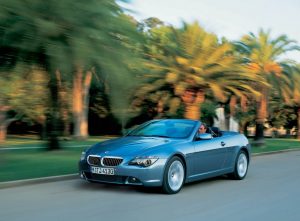Recalls: BMW E64 6-Series convertible
Overview
Manufacturers, or importers, issue recalls for defects or faults which have the potential to cause injury. Generally, manufacturers will inform the original buyers if their vehicle is subject to a recall and of the steps required to remedy the defect or fault. Please note that the recalls below (if any) are for Australian-delivered vehicles only. Furthermore, the number of recalls should not be taken as an indication of a model’s reliability or its safety more generally.
Recalls: BMW E64 6-Series convertible
- In July 2006, a recall was issued for BMW E64 6-Series Convertible vehicles manufactured from 9 January 2006 to 26 April 2006. In these vehicles, the lower rubber mounts could come loose from the rear shock absorbers – if this occurred, wheel guidance would be lost and, depending on the driving situation, it may not be possible to control the vehicle safely (PRA 2006/8620).
- In October 2010, a recall was issued for BMW E64 6-Series Convertible vehicles with V8 petrol engines that were available for sale prior to 30 November 2009. In these vehicles, engine oil from the brake vacuum pump may enter the brake vacuum line and potentially the brake booster. The engine oil may cause leaks in the brake booster’s internal rubber membrane which would impair the brake power assistance system – as such, an increased level of brake pedal pressure would be required to slow the vehicle (PRA 2012/13090).
- In March 2012, a recall was issued for all BMW E64 6-Series convertibles that were available for sale up to 31 July 2010. In these vehicles, the battery cover may not have been correctly clipped to the floor panel due to an assembly error – this could cause loosening and possible overheating of the positive terminal cable connection which could, in turn, result in a fire in the luggage compartment even if the engine was not running (PRA 2012/13082).
Problems and faults: BMW E64 6-Series Convertible
Overview
This section identifies potential problems, causes and fixes based on the experiences of owners and repairers, online sources and technical service bulletins. This information is provided solely for reference purposes and AustralianCar.Reviews recommends that only properly qualified persons carry out repairs or modifications. Furthermore, the number of items below should not be taken as an indicator of a model’s reliability or the frequency with which they may occur.
To report a problem or fault to the AustralianCar.Reviews team, please use the Contact Us form. Note that AustralianCar.Reviews does not offer advice on automotive problems or disputes; such enquiries will not receive a reply. For vehicles purchased from dealers after 1 January 2011, please see our Australian Consumer Law fact sheet.
E64 645ci and 650i: N62 engine and variable idle
In January 2006, BMW issued technical service bulletin SI B 11 02 05 for BMW E64 645ci and 650i Convertibles with the N62 engine that were manufactured from June 2004 to February 2005. In these vehicles, the driver may experience erratic or variable idle speed for around 20 seconds after a cold start. Furthermore, the ‘check engine soon’ light may illuminate and misfire faults may be logged in the DME (e.g. FC 2742, 2743, 2744, 2745, 2746, 2748, 2749 and 274E).
According to the service bulletin, this condition was due to incorrect tolerances and geometry of the ‘Valvetronic’ intermediate levers causing uneven cylinder filling during the transitional cold start period (60 seconds after start-up) when the Valvetronic system was switching from the initial 6 mm to a minimum 0.3/0.8 mm valve lift.
To fix, the Valvetronic intermediate levers were to be replaced.
E63 6-Series: N62 and N62TU engine deposits
In February 2008, BMW issued technical service bulletin SI B 13 01 07 for E63 6-Series Convertibles with N62 or N62TU engines. In these vehicles, deposits in the injection and induction system may cause driveability complaints and the ‘Service Engine Soon’ light to be illuminated. This condition could be caused by:
- Deposits at the fuel injector’s tip which affected fuel flow and the air/fuel mixture ratio. Symptoms included hesitation or stumble during acceleration or loss of power; poor fuel efficiency; increased HC and CO emissions; and, the ‘Service Engine Soon’ lamp to illuminate due to misfire faults;
- Carbon deposits at the valves and on the intake manifold ports absorbing fuel during the warm-up phase, causing a leaner air/fuel mixture. Carbon deposits (or build-up) could also disturb the mixture flow at low throttle conditions and/or idle speeds. Symptoms of carbon deposits included a loss of power; unstable and/or rough idle; increased HC, CO and NOx emissions; and, the ‘Service Engine Soon’ lamp to illuminate due to intermittent misfire faults; and,
- Combustion Chamber Deposit Interference (CCDI) when there was contact between carbon deposits on the piston crown and the cylinder head. The noise created by this contact may be misdiagnosed as a ping, knock or other mechanical failure. CCDI occurs first as a cold start noise that can fade as the engine reaches operating temperature. As deposits build, there is an increase in compression temperature that may cause pre-ignition detonations. Symptoms include knocking, pining, poor acceleration, increased NOx emissions and engine idle speed surges.
E64 6-Series: ZF transmission sealing sleeve seepage
In March 2010, BMW issued technical service bulletin SI B 24 08 06 for BMW E64 6-Series vehicles with ZF six-speed 6HP19/21 or 6HP26/28 transmissions that were manufactured up to April 2008. In these vehicles, transmission fluid seepage may be visible in the area of the transmission oil pan; the service bulletin attributed this condition to the tightness of the Mechatronic sealing sleeve’s O-ring. Only if a visible leakage trace indicated a substantial loss of transmission fluid was the Mechatronic sealing sleeve (part no. 24 34 7 588 725) to be replaced.
E64 6-Series: active steering sensor failure
In September 2006, BMW issued technical service bulletin SI B34 05 06 for BMW E64 6-Series Convertibles that were manufactured from 26 August 2005 to 28 July 2006. In these vehicles, the optical sensor in the SZL (Steering Column Switch Sensor) may fail. According to the service bulletin, a defective optical steering angle sensor could cause failure of:
- Active Steering;
- Dynamic Stability Control (DSC);
- Active Roll Stabilization (ARS);
- Adaptive Headlights (AHL);
- Active Cruise Control (ACC); and,
- The automatic turn signal reset function.
Please note that one or more systems may fail depending on the degree of damage to the optical steering angle sensor. Furthermore, the failure of DSC, ARS and Active Steering would be indicated by indicator lamps and display messages. To fix, the optical sensor in the SZL was to be replaced.
Problems and faults: BMW E64 6-Series convertible
- If there is a rattling noise from the front of the engine and the ‘check engine’ light illuminates, there may be a leak in an oil line for the variable valve timing system.
- If the ‘check engine’ light is illuminated and the engine is running rough, the camshaft position sensors may have failed.
- For models fitted with the 4.8-litre V8 petrol engine, the right side (cylinders 1-4) valve cover or oil filler cap could break in cold weather due to a build-up of ice in the vent hose or valve.
- If a ‘rollover protection fault’ message appears on the driver information centre, there may be a problem in the wiring or with the connectors.
- The ‘electronic steering lock’ warning light may illuminate if battery was low when starting.
- The ‘convertible roof’ warning light may give false readings (i.e. indicating the roof is not fully open or closed when it actually is) due to a faulty sensor.
- The automatic headlights may not turn off when exiting a tunnel or parking garage due to a miscommunication between the sensor and headlight module.
- For models with steering wheel gearshift paddles, the paddles may stop working due to loose connectors terminating the electrical circuit.
- For early models, the lens for the centre high-mounted stop lamp (CHMSL) was susceptible to cracking at the sides.
- Where fitted, the night vision display may malfunction due to a damaged wiring harness (near headlights).
- The universal garage door opener may not accept a code from a different source (i.e. a new transmitter or new owner) if the batteries in the transmitter are low.




